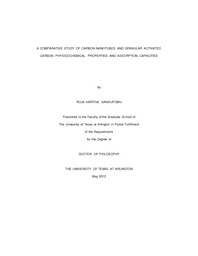
ATTENTION: The works hosted here are being migrated to a new repository that will consolidate resources, improve discoverability, and better show UTA's research impact on the global community. We will update authors as the migration progresses. Please see MavMatrix for more information.
Show simple item record
| dc.contributor.author | Gangupomu, Roja Haritha | en_US |
| dc.date.accessioned | 2014-09-17T17:29:39Z | |
| dc.date.available | 2014-09-17T17:29:39Z | |
| dc.date.issued | 2014-09-17 | |
| dc.date.submitted | January 2013 | en_US |
| dc.identifier.other | DISS-12135 | en_US |
| dc.identifier.uri | http://hdl.handle.net/10106/24734 | |
| dc.description.abstract | Adsorption technologies with activated carbon have proven their prominence in wide variety of industrial applications for the removal of pollutants from gaseous streams for generations. Nanoadsorbents due to their unique structure and the presence of high-energy binding sites can enhance adsorption of pollutants, particularly for hazardous pollutants difficult to control using conventional sorbents like activated carbon and can help industries in their struggle for greener technologies. The objective of this study was to characterize raw and purified CNTs and compare their physical and chemical properties to commercially available granular activated carbon (GAC). The CNT purification process was done in two steps: the samples were first heat-treated at 4000C in a steam atmosphere, followed by acid treatment. In the acid treatment, the CNTs were chemically treated with different concentrations (3N, 5N, 11N, and 16N) of nitric acid for various time spans (3hr, 6hr, 9hr, 10hr, and 12 hr) in an ultra-sonic bath. This study reports physical and chemical properties of CNTs and GAC including morphology; Brunauer, Emmett and Teller-nitrogen surface area, total pore volume, and pore size distribution; and results of Inductively Couple Plasma-Mass Spectrometry (ICP-MS), Raman Spectroscopy, X-ray photoelectron spectroscopy (XPS) and Thermogravimetric analyses (TGA). Adsorption of toluene onto CNTs and GAC was conducted using a gas chromatography-flame ionization detector to assess the adsorption capacity and the removal efficiency of the adsorbents. Breakthrough curves and time series plots were developed to obtain the aforementioned parameters. ICP-MS results showed the presence of metal impurities and Silica in the SW and MW raw samples. Transmission electron microscopy results showed that the nitric acid treatment developed corrugations on the walls of nanotubes and removed impurities. The XPS and Raman results showed that complete removal of amorphous carbon occurred for the SWNTs treated with 3N nitric acid for 3 hours. XPS also showed a few surface functional groups on the purified samples, but these surface functional groups did not ultimately improve the adsorption capacity of the sample for toluene. TGA testing confirmed the results from the above the three experiments, but also showed that the purified MWNTs had a lower stability than the raw sample. The adsorption capacity of GAC and SW 33 were 385 mg/g and 383 mg/g, respectively. The purified SWNTs and MWNTs showed a higher adsorption capacity than the raw SWNTs and MWNTs. The purified samples except for the SW 33 sample had a decrease in the surface area ranging between 890 m²/g and 1100 m²/g, while the pristine sample had a surface area of 1136 m²/g. This study indicates that purification of carbon nanotubes can make their physical and chemical properties comparable to granular activated carbon. It is important to note that heat and nitric acid treatment that caused different degrees of enhancements in the pore structure, chemical structure and surface chemistry in this study may not produce the same enhancements for carbon nanotubes from different sources. | en_US |
| dc.description.sponsorship | Sattler, Melanie L. | en_US |
| dc.language.iso | en | en_US |
| dc.publisher | Civil & Environmental Engineering | en_US |
| dc.title | A Comparative Study Of Carbon Nanotubes And Granular Activated Carbon: Physicochemical Properties And Adsorption Capacities | en_US |
| dc.type | Ph.D. | en_US |
| dc.contributor.committeeChair | Sattler, Melanie L. | en_US |
| dc.degree.department | Civil & Environmental Engineering | en_US |
| dc.degree.discipline | Civil & Environmental Engineering | en_US |
| dc.degree.grantor | University of Texas at Arlington | en_US |
| dc.degree.level | doctoral | en_US |
| dc.degree.name | Ph.D. | en_US |
Files in this item
- Name:
- Gangupomu_uta_2502D_12135.pdf
- Size:
- 4.026Mb
- Format:
- PDF
This item appears in the following Collection(s)
Show simple item record


